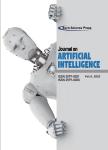Comparative Analysis Using Machine Learning Techniques for Fine Grain Sentiments
作者机构:Department of Computer ScienceUniversity of GujratGujrat50700Pakistan Faculty of Computing and InformaticsUniversity Malaysia SabahJalan UMSKota Kinabalu88400SabahMalaysia Department of Computer Science and EngineeringHanyang UniversitySeongdong-guSeoul04763South Korea Faculty of Computing&InformaticsMultimedia UniversityCyberjaya63100SelangorMalaysia Department Computer Science and TechnologyChang’an UniversityXi’an710064China
出 版 物:《Journal on Artificial Intelligence》 (人工智能杂志(英文))
年 卷 期:2022年第4卷第1期
页 面:49-60页
学科分类:08[工学] 0812[工学-计算机科学与技术(可授工学、理学学位)]
主 题:Machine learning neural network sentiment analysis system support vector machine
摘 要:Huge amount of data is being produced every second for microblogs,different content sharing sites,and social *** classification is a tool that is frequently used to identify underlying opinions and sentiments present in the text and classifying *** is widely used for social media platforms to find user’s sentiments about a particular topic or ***,assembling,and analyzing sentiments has been challenge for *** handle these challenges,we present a comparative sentiment analysis study in which we used the fine-grained Stanford Sentiment Treebank(SST)dataset,based on 215,154 exclusive texts of different lengths that are manually *** present comparative sentiment analysis to solve the fine-grained sentiment classification *** proposed approach takes start by pre-processing the data and then apply eight machine-learning algorithms for the sentiment classification namely Support Vector Machine(SVM),Logistic Regression(LR),Neural Networks(NN),Random Forest(RF),Decision Tree(DT),K-Nearest Neighbor(KNN),Adaboost and Naïve Bayes(NB).On the basis of results obtained the accuracy,precision,recall and F1-score were calculated to draw a comparison between the classification approaches being used.



